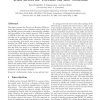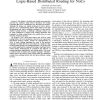111
Voted
IJSNET
2008
15 years 21 days ago
2008
Delivering sensed data to the sink reliably in sensor networks calls for a scalable, energy-efficient, and error-resilient routing solution. In this paper, a reliable energy-effic...
103
Voted
IJNSEC
2008
15 years 21 days ago
2008
This paper presents the Trust Level Routing (TLR) protocol, an extension of the optimized energy-delay routing (OEDR) protocol, focusing on the integrity, reliability and survivab...
115
click to vote
CAL
2007
15 years 21 days ago
2007
—The design of scalable and reliable interconnection networks for multicore chips (NoCs) introduces new design constraints like power consumption, area, and ultra low latencies. ...
116
Voted
IJIPT
2008
15 years 22 days ago
2008
Mobile ad-hoc networks (MANETs) are infrastructure-less networks where no central network management exists, composed of mobile nodes over wireless links. Network topology in MANE...
92
Voted
IJAHUC
2008
15 years 22 days ago
2008
: Traditional ad hoc routing protocols do not work in intermittently connected networks since end-to-end paths may not exist in such networks. Hence, routing mechanisms that can wi...
60
Voted
DM
2006
15 years 22 days ago
2006
The notion of the carvingwidth of a graph was introduced by Seymour and Thomas [Call routing and the ratcatcher, Combinatorica
110
Voted
COR
2006
15 years 22 days ago
2006
Arc Routing Problems on mixed graphs have been modelled in the literature either using just one variable per edge or associating to each edge two variables, each one representing ...
95
Voted
COR
2006
15 years 22 days ago
2006
A well known transformation by Pearn, Assad and Golden reduces a Capacitated Arc Routing Problem (CARP) into an equivalent Capacitated Vehicle Routing Problem (CVRP). However, tha...
107
click to vote
COMCOM
2006
15 years 23 days ago
2006
This paper presents a secure alternate path routing in sensor networks. Our alternate path scheme makes the routing protocol resilient in the presence of malicious nodes that laun...
106
Voted
COMCOM
2006
15 years 23 days ago
2006
In optical networks, the traditional routing problem is generally decoupled into two subproblems, the route selection and the wavelength assignment. Usual RWA (Routing and Wavelen...


